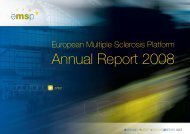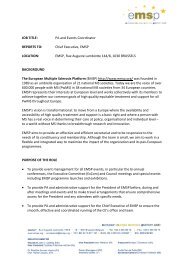Symptomatic Treatment of MS - European Multiple Sclerosis Platform
Symptomatic Treatment of MS - European Multiple Sclerosis Platform
Symptomatic Treatment of MS - European Multiple Sclerosis Platform
Create successful ePaper yourself
Turn your PDF publications into a flip-book with our unique Google optimized e-Paper software.
Drug treatment <strong>of</strong> these pain syndromes should follow published guidelines for therapy <strong>of</strong> degenerative<br />
arthropathies since no <strong>MS</strong>-specific studies exist [Eccles 1998].<br />
Pain as well as painful sensory symptoms due to pressure lesions or chronic entrapment (e.g. <strong>of</strong> peroneal<br />
nerve), <strong>of</strong> carpal tunnel or sulcus ulnaris syndrome require adjustment <strong>of</strong> mechanical aids (splints, wheel<br />
chairs, sticks) completed by physiotherapy and occupational therapy, especially if pronounced ataxia or<br />
spasticity is present. Prevention <strong>of</strong> decubital ulcers requires optimization <strong>of</strong> posture, body position, and<br />
special beds and mattresses<br />
Pain following drug treatment: Local pain during treatment with beta interferons or glatirameracetate<br />
may be prevented by application <strong>of</strong> cold packs before and after injection and by optimized<br />
mode <strong>of</strong> injection as indicated in the patient brochures. Flu-like symptoms with muscular pain can be<br />
alleviated with paracetamol, acetaminophen, ibupr<strong>of</strong>en, other non-steroidal antirheumatics or lowdose<br />
corticosteroids. The effectiveness <strong>of</strong> these drugs is widely comparable [Rio 2004; Reess 2002].<br />
Increasing headache during beta interferon treatment may be reduced following published guidelines<br />
<strong>of</strong> the national headache societies.<br />
<strong>MS</strong>-independent pain: The syndrome <strong>of</strong> “low back pain” is present in up to 40% <strong>of</strong> <strong>MS</strong> patients due to<br />
one or several <strong>of</strong> the following: immobilisation, muscle tenseness, spasticity <strong>of</strong> truncal muscles, osteoporosis,<br />
chronic degenerative disc disorders and vertebral joint disease. Again, physical therapy to<br />
optimise body posture and transfer is <strong>of</strong> general help associated with well-fitted ortheses where<br />
appropriate. In some studies, chronic lumbar pain physiotherapy has proven to be effective [Philadelphia<br />
Panel Low back pain 2001] as well as acupuncture massage which was claimed to be superior to<br />
conventional massage [Furlan 2001]. Drug treatment should be performed according to that for<br />
chronic neck and shoulder pain [Eccles 1998].<br />
Lumbar, pelvic and iliosacral pain <strong>of</strong>ten are pseudoradicular in origin. In radicular pain, disc herniation<br />
should be looked for. In osteoporosis, biphosphonates are the treatment <strong>of</strong> choice [Gangji 1999]. It<br />
should be kept in mind that repeated corticosteroid treatment at short intervals (e.g. monthly) is likely<br />
to aggravate osteoporosis.<br />
In the complex situation <strong>of</strong> multiple pain states one should also consider surgical interventions, e.g. in<br />
pr<strong>of</strong>ound disc protrusion or in a narrow spinal canal with possible spinal cord compression whenever<br />
this is likely to cause the pain syndrome.<br />
13 E<strong>MS</strong>P, <strong>Symptomatic</strong> <strong>Treatment</strong> <strong>of</strong> <strong>Multiple</strong> <strong>Sclerosis</strong>, December 2006 - revised in April 2008






